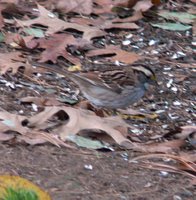
The birding has been so great all Spring and Summer, with my new camera, I had forgotten the joys of birding in the Autumn and Winter. The biggest joy is that the leaves are gone and I can see the birds a lot easier! I've been searching online for a site that lists the birds that winter over in this area, to see who I am forgetting, or otherwise not recognizing, but haven't found much yet. The biggest problem is that it stays dark so much longer, Saturdays and Sundays are going the be the only time to watch the birds.
While raking leaves today, we got all the feeders refilled. I even took the screen off the kitchen window so I can use the binoculars and camera from inside without the screen making every photo look fuzzy. Some will still be fuzzy, of course, when my hand shakes, but why start with one strike against you?
As the Summer closed, I noticed that the birds no longer sang so early and so loud in the morning. As I walked to the bus before 7:00 am, it was dark, and I heard no birds at all. Since the change to Eastern Standard Time and more light in the morning, I hear more birds during the walk to the bus stop. My faithful Carolina Wrens sing and scold as I walk down the street. This Wren photo was obviously taken in the Summer, but it's the best one I have and I wanted to show it off.

Blue Jays were not in my backyard all Summer, but I saw quite a few this afternoon. I never noticed Jays migrating before, but they all seemed to heading South as we returned from Virginia. I wonder how long these will stick around.

The White Throated Sparrow blends perfectly with the leaves under the feeder both due to his coloration and the close resemblance to a House Sparrow if you don't look closely. It was good to hear him calling for Sam Peabody again.

Of course, the Dark Eyed Juncos have moved in for the winter. They are also camouflaged in the leaves. I hope to get some of the classic photos of the Northern Cardinal in the snow at my feeder. Maybe Santa will even bring me some feeders that don't have squirrel teeth marks on them!


